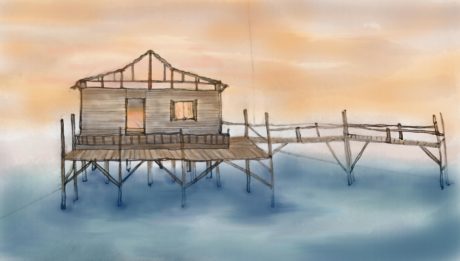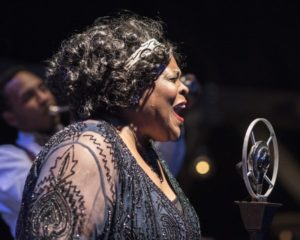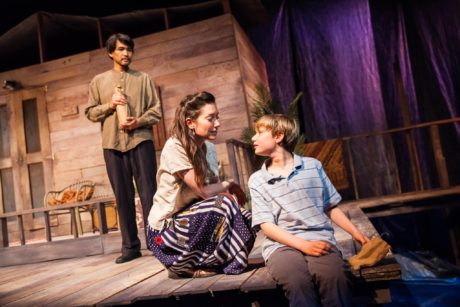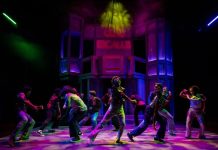
Deb Sivigny is one busy scenic and costume designer in the DC theater community. Just recently, she developed design elements for the Rorschach Theatre production of Forgotten Kingdoms. The 1st Stage production of August Wilson’s Ma Rainey’s Black Bottom uses Deb’s costume design. And Deb is the scenic and costume designer for the upcoming Hub Theatre regional premier production of The Happiest Place on Earth by Philip Dawkins.
So how does anyone do all of that, and so well, I kept asking myself. Then I thought I am the wrong person to ask. So I asked Deb how she does it. What are her secrets for working on disparate productions at nearly the same time? My questions were not focused on a particular production; they were wider ranging, about her journey to become a designer.
This column is Part I of a two-part interview with Deb Sivigny. Part II will follow soon.
David Siegel: What led you to become a designer, both costume and scenic designer? Was it a conscious decision or did it “just happen?”
Deb Sivigny: I have been sewing since I was nine years old. I was intrigued by my mom’s old Singer sewing machine, and her unfinished dresses from the 70s. My mother loved beautiful things and had a natural eye for composition. My father was an engineer and used to help me build scale models for school and for fun. I’ve been making art as far back as I can remember in a variety of mediums – paper, paint, clay, fabric. I didn’t know that designing could be a career path until college. It was a totally unexpected path, to be honest, but it combined my love of the arts, history, language, and narrative in a style… it was just the right place for me.
Scenic design is a more recent career development for me. While I studied it through undergraduate and graduate school, my first scenic design wasn’t until 2006, and I’ve only been doing it regularly for the past two years. I don’t actually know why I waited so long. I give huge credit to Jenny Frederick of Source Festival (and Rorschach Theatre) for getting me out of my shell with two seasons of festival scenic designs.
My current path has been a little labyrinthine. I spent a few years working as a wardrobe stylist and tailor while also balancing a full time teaching schedule at Georgetown. I’ve done a few wedding designs, including a few custom dresses. I am finally getting comfortable with saying I do both scenic and costume design. I’m also branching out into play writing with The Welders. My play, maybe more aptly named a “theatrical event,” will be produced this October in Takoma Park. It’s called Hello, My Name Is…. It’s my first formal leap into creating an immersive, site-reactive, design-forward event for an audience.

Is there a “Sivigny” style of design? If so, how would you describe that style?
I would like to say my style is unique, but also chameleonic. I don’t think about putting my personal stamp on a design. My job is to serve the story and tell it in the most effective way possible. I am always a bit surprised when someone who sees my work can identify that it’s mine. I enjoy flattering bodies, no matter what shape. I’m really picky about the fit and proportion of a garment. I need my scenery to enhance and utilize the space it’s in. Every choice is deliberate. If I have to say “oh, well… it is what it is…” I consider that a failure. I’m a realistic perfectionist.
My style has been shaped by the plays I’ve designed – my undergrad years at Middlebury had me designing lots of distressed, dirty characters and I learned how to stretch a budget really far. My grad years at University of Maryland taught me to dream big ideas, consider aesthetic influences and movements, and think about intercultural dialogues. Now I’m beginning to see design and theatre as a political act, an influencer, and a manipulator of the world we know.
What steps do take from first knowing you will be developing the costume design to the final design that audiences see? What influences you?

After reading through the script several times, until things become intuitive and ingrained, I try to find a personal, grounded way into the script through its players. My work in costume design is deeply character and actor based. I like to delve into research that goes beyond just the clothes – it’s about a twinkle in an eye, understanding the essence that the actor cast in the role brings to the work.
When I find the confluence of these elements, I get to sketching. Sometimes, I sketch for myself to get a better sense of what’s in my own head. While I do a lot of pre-production design work, I make the majority of the final design decisions in the fitting process. Even a quick 30 minutes in the room with an actor gives me the confidence to make decisions that work for the production, the director, and the actor. I feel that my job begins with listening to the script/playwright, to the director and my fellow designers, and to my own intuition. The collaboration with actors adds the spark that my designs need and eventually we end up with alchemy, and maybe a bit of anarchy.
What steps do you take for a scenic design? What influences you?
Scenic design requires serious brain gymnastics. I try to find the large thematic container for the world that communicates where we are in time and space, and then I zoom in to the smallest minutia where humans intersect with that space. Even the most abstract set has details that personalize and incorporate human factors. I strongly believe that actors need to understand and trust their theatrical world, thematically, logistically, and creatively. I am personally very interested in immersive environments and how the familiar can invoke memory.
What makes designing scenery complicated for me is the back and forth of art versus logistics. Costume designing requires this skill as well, but because I am well versed in how garments are made and engineered, I can navigate the transition with ease. While I built things from wood as a teenager and used power tools without fear, my understanding of large physical structures is limited. I have to deliberately turn off the “what if… gravity” part of my brain when I design scenery because it can seriously stunt the work. I end up having to put enormous trust in technical directors.

Part II of my interview with Deb Sivigny will follow soon.
LINKS:
John Stoltenberg’s review of Forgotten Kingdoms.
William Powell’s review of Ma Rainey’s Black Bottom.




